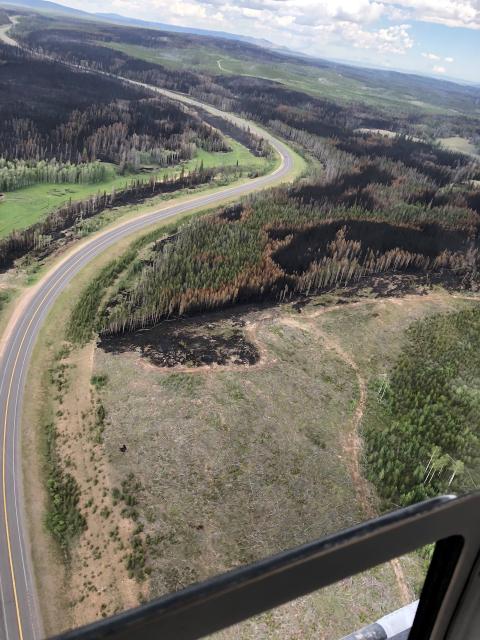Hundreds of Wyoming homes spared during wildfire due to proactive fuel breaks; defensible space
Photo Credit: USDA Forest Service
Friday, July 27, 2018
 Fire and forestry managers on the ground in Wyoming say that wildfire fuel breaks – created with inexpensive tree thinning projects over six years ago – spared hundreds of homes from certain devastation last month.
Fire and forestry managers on the ground in Wyoming say that wildfire fuel breaks – created with inexpensive tree thinning projects over six years ago – spared hundreds of homes from certain devastation last month.On June 10 near the Wyoming-Colorado border, a wildfire started in the Medicine Bow-Routt National Forest just two miles northwest of the Mountain Home subdivision. Within 72 hours of igniting, the Badger Creek Fire had grown to more than 11,000 acres in size.
“Everything happened fast,” says Travis Pardue, assistant district forester for the Wyoming State Forestry Division (WSFD). “Not only did the fire move quickly, it was pretty unexpected given the time of year, so we didn’t have time to prepare subdivisions, much less the manpower to protect them while we evacuated 400 residences. Really the only thing protecting those subdivisions was the fuel breaks.”
The 339 acres of fuel breaks that Pardue says “saved the Mountain Home and Wold Tract subdivisions” were put in by the USDA Forest Service in 2011 and 2012 on and nearby the Medicine Bow-Routt National Forest. These thinning treatments cost just $1,000 an acre – a drop in the bucket compared to the $12 million the Badger Creek Fire cost to suppress – and were planned and implemented in concert with WSFD and Albany County.
“With the fuel breaks, firefighters had enough of a buffer to safely direct retardant drops from air tankers,” says Reed Oldenburg, fuels mitigation coordinator for WSFD. “The fire never did get established within or across the fuel treatments.”
Several of the engines used to fight the Badger Creek Fire came to rural Wyoming via the Federal Excess Personal Property and Firefighter Property programs. Much of the state’s other firefighting equipment and training is also provided by WSFD in cooperation with the Forest Service through the State Fire Assistance and Volunteer Fire Assistance programs.
“We count on our federal and local partners and they count on us,” said Wyoming State Forester Bill Crapser. "Together is the only way we can protect Wyoming residents and their homes from wildfire, now and in perpetuity."
“Across the West, the question of wildfire is not if but when,” said Forest Service Rocky Mountain Regional Forester Brian Ferebee. “The outcome of the Badger Creek Fire is a good example of how we are utilizing authorities granted by Congress to better protect our communities and be good neighbors where public and private lands meet.”
Pictured in Cover Photo: Near the heel of the Badger Creek Fire. Pictured are structures in the Wold Tract community. Fuel break was cut in 2005. Photo Credit: USDA Forest Service.
Pictured to Right: Near the heel of the Badger Creek Fire and north and east of Mountain Home community. Gramm recreation residences are in the green area near the top of the photo. Bottom treatment is Wyoming State land, treated in 1997 and 98, then again in 2011. Top green area near the Gramm cabins in the Gramm Fire scar from 2007. State land treatment and the fire scar funneled the fire away from Gramm cabins and possibly prevented the fire from traveling south across the Wyoming/Colorado state line. Photo Credit: USDA Forest Service.